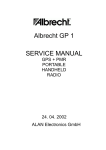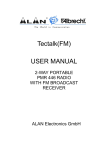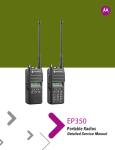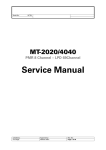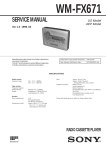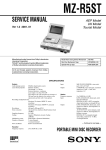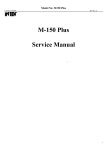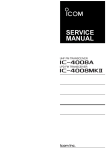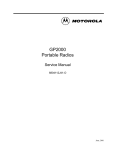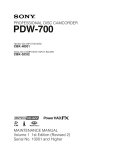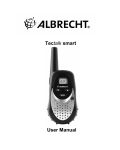Download Tectalk(FM) SERVICE MANUAL
Transcript
Tectalk(FM) SERVICE MANUAL 2-WAY PORTABLE PMR 446 RADIO WITH FM BROADCAST RECEIVER Nov. 07. 2001 ALAN Electronics GmbH CONTENT 1. GENERAL 1.1 General 1.2 Characteristic 1.3 Composition 2. SPECIFICATION 2.1 General Specification 2.2 Electrical Specification 3. OPERATION 3.1 Drawings of the radio 3.2 ICONS on LCD 3.3 Key Functions 3.4 Setting and Operation 4. ADJUSTMENT 4.1 Frequency synthesizer 4.2 Transmitter 4.3 Transmitter Test 4.4 Receiver 4.5 Receiver Test 4.6 Symptoms, check point & Correction 5. DESCRIPTION OF RADIO CIRCUIT 5.1 Frequency Synthesizer 5.2 Receiver 5.3 Transmitter 6. BLOCK DIAGRAM 7. SCHEMATIC DIAGRAM 8. COMPONENT PART LIST 9. EXPLODED VIEW 10. CHANNEL DATA (With Sub-Channel data) 1. GENERAL 1.1 GENERAL This equipment, Tectalk(FM) is called 2 way PMR 446 portable handheld radios. The frequency range is 446.00625 ~ 446.09375MHz, UHF operating Channels for European PMR 446 2 way portable radios. Also, this unit have built-in FM Radio which receives FM Broadcast Radio frequencies in the 87.5 ~ 108MHz band. 1.2 CHARACTERISTIC a) All active device in this radio is composed of semiconductor and high density IC. b) To design this radio in compact and weight approximately 130g including battery. C) CPU of this equipment is HD404889 from HITACHI. d) You can use PMR 446 and FM Radio with this unit at the same time. e) It's power can operate by use of ALCALINE 4 cell(1.5V AAA) battery 1.3 COMPOSITION This radio is composed of following. a) Transmitter(W/Antenna) b) Belt clip 2. SPECIFICATION 2.1 GENERAL SPECIFICATIONS a) Frequency Range : 446.00625 to 446.09375 MHz b) Output Impedance : 50 Ohms (internal) unbalanced c) Modulation Type : 8K50F3E d) Communication Mode : Simplex e) Channel Capacity : 8 channel f) Channel spacing : 12.5 KHz g) Power : 6.0V(Alkaline) h) Battery Life : Alcaline 1000mAh > about 35hours NI-MH 600mAh > about 22hours ( Tx5%, Rx5%, Stand-by 90% ) i) Operating Temperature : -20°C to +55 °C j) Dimension : 95.5(H)x 50(W)x 26(D)mm k) Weight : 130g(with Battery) 2.2 ELECTRICAL SPECIFICATION a) TRANSMITTER 1) Output power : Max. 0.5 W 2) Frequency Stability : +/- 5 ppm(-20°C to +55°C) 3) Modulation Method : FM 4) Oscillation Method : PLL SYNTHESIZER 5) Max. Frequency Deviation : < +/- 2.5 KHz (with tone) 6) Cooling Method : air-cooling Method 7) Spurious Emission TX: < -36dBm 8) FM Hum/Noise : > 40dB(1kHz 60% modulation) 9) Distortion : < 5% (1kHz 60% modulation) 10) Tx Audio Response : 6dB /OCT +/- 3dB preemphasis (300Hz to 2.5kHz) b) RECEIVER 1) Receive Method : Double Super Heterodyne 2) Receive Sensitivity : -118dBm up (20dB SINAD W/CCITT) 3) Squelch Sensitivity : -120dBm to -130dBm (AUDIO On/Off Point) 4) Bandwidth : > 8.5KHz 5) Selectivity : > 55dB 6) Local Frequency Stability : +/-5ppm(-20°C to +55°C) 7) Spurious Response Rejection : > 65dB 8) Audio output : 200mW (8 Ohms load THD 10%) 9) Distortion : < 5% (1kHz 60% Modulation) 10) RX Audio Response : 6dB/OCT +1/-10dB deemphasis (300Hz -2.5kHz) 11) S/N Ratio : < 40dB(1kHz 60% Modulation) 12) IF : 1'st IF = 21.7MHz 2'nd IF = 450kHz 13) Local Frequency : 1’st Local Frequency = fc - 21.7MHz 2’nd Local Frequency = 21.25MHz c) FM Broadcast Radio 1) Receive Method : Heterodyne 2) Receive Sensitivity : Min –90dBm(12dB SINAD) 3) Local Frequency : 1’st Local Frequency = fc – 75KHz 3. OPERATION 3.1 Drawings of the radio FUNCTIONS AND CONTROLS 1) Battery Door 2) Monitor Button 3) Detachable Belt Clip 4) Push-To-Talk (PTT) Button 5) Antenna 6) External MIC / Speaker 7) Built-in Speaker 8) LCD Panel 9) Built-in Microphone 10) UP Button & Volume Control 11) DOWN Button & Volume Control 12) Function Button 13) Power On/Off & Enter Button 3.2 ICONS on LCD 1. RSSI (Receiving Signal Strength Indicator) or TX Bar Icon Indicates the receiving signal strength during transmission and it can be indicated the number of bar according to the strength of receiving signal. 2) Monitor Indicator Appears when the monitor button is used. 3) CTCSS Indicator Blinks when the correct CTCSS tone is entered. 4) Auto Channel Scan Indicator Appears in the normal scan mode or when the normal scan mode is activated. 5) Priority Scan Indicator Appears in priority scan mode or when the priority scan mode is activated. 6) VOX Indicator Blinks in VOX selection mode or appears when VOX is activated. 7) Key Lock Indicator Blinks in auto lock selection mode or when the key lock is activated. 8) FM RADIO Mode Indicator This icon appears when the FM RADIO is selected. 9) Battery Level Indicator Battery Level Meter indicates the remaining battery strength. 10) Tx Indicator Appears when a signal is being transmitted. 11) Rx Indicator Appears when a signal is being received. 12) Large Segment Display Indicates the channel number in use at the normal mode. When the Function Button is pressed, it Displays the function menu in sequence: Ch / rdo / Sc / Uo / H00 / Sub / CAL / bEP / rog / tAL / [1] / [2] / [3] / P1 / P2 / P3 / P4 / P5 13) Small Segment Display Displays the FM frequency at the FM mode. Displays the SUBMENU of each MENU in the function mode. 13.1 Main Menu CH: 1~8 , 0-38(ctcss channel) rdo : OFF, ONLY, PLUS SC : nr, Pr(1-8), OFF VO : Hi, nr, Lo, OFF / 1, 2, 3, 5 sec (Vox Delay Time) H00 : 00-99, 00-99 13.2 Sub Menu Sub : yES, NO CAL : 1-7, OFF bEP : On, OFF rog : On, OFF tAL : On, OFF [1],[2],[3]: 1-8, 1-38 P1,P2,P3,P4,P5 : 87.5-108 3.3 Key Functions 3.3-1 POWER ON/OFF & SHIFT BUTTON (#13) 1) Short Touch - Power On a) When FM RADIO is OFF Press this button (#13) briefly to turn the unit on. A short confirming melody will play. A momentary press of this button is not effected to any function in the Function edit mode and stand-by mode except in the specific mode. b) When FM radio is on Pressing this button allows you to shift to next preset FM radio Broadcasting. 2) Long Touch - Power Off Press this button (#13) for longer than 1.5 seconds to turn the unit off. A momentary press of this button is also used to shift to the other small segment display during the function edit mode and reset the stopwatch counter in the stopwatch mode. 3.3-2 FUNCTION BUTTON (#12) 1) Short Touch - Press this button briefly to enter function edit mode in standby mode. 2) Long Touch - Press for longer than 1.5 seconds to activate the KEY LOCK in the standby mode. Please note all buttons will be disabled except the Monitor Button (#2) and PTT Button (#4) will remain fully operational. 3.3-3 UP BUTTON (#10) 1) Short Touch - In the standby mode, press this button briefly to move to the next higher main volume level. - In the function edit mode, press briefly to shift from the current option in each submenu to the next option in the same submenu. 2) Long Touch - Pressing this button for more than 1.5 seconds will allow you to navigate at a more rapid rate through different volume level in the standby mode or through different menus in the function edit mode. 3.3-4 DOWN BUTTON (#11) 1) Short Touch - In the standby mode, press this button briefly to move to the previous lower main volume level. In the function edit mode, press briefly to shift from the current option in each submenu to the previous option in the same submenu. 2) Long Touch - Pressing this button for more than 1.5 seconds will allow you to navigate at a more rapid rate through different volume level in the standby mode or through different menus in the function edit mode. 3.3-5 PUSH-TO-TALK (PTT) BUTTON (#4) - Press it firmly and speak into the Built-in Microphone (#9) to transmit. The red Tx LED Indicator at the right side of the LCD Panel (#8) will light. - Release it to revert to standby mode. When an incoming call is received, the green Rx LED Indicator on the left side of the LCD Panel (#8) will light. 2-Way Call Ringer Press the PTT Button twice quickly to call another party on the same channel and pressing the button once during and pressing the button once during a calling stops the calling and then returns to the standby mode. The user selected call ringer melody will play. 3.3-6 MONITOR BUTTON (#2) - Press it to check activity on the current channel before you try to transmit. - Adjust the Volume Control (#10, #11) if necessary. - When you press the Monitor Button, the LCD Panel (#8) will be illuminated with an amber color back-light and both the Tx and Rx LED Indicators will light. - If you press and hold the monitor button for more than 3 seconds, the monitor appears on the LCD panel and monitor the receiving signal continuously. - To stop the monitoring press the Monitor Button (#2) and return to the standby mode. Press it to confirm the required option for respective functions during function edit mode. 3.3-7 EXTERNAL MIC/SPEAKER (#6) - This jack accepts an optional headset/microphone for handsfree operation. - Please refer to the Albrecht catalogue or homepage to see the variety of available accessories. See also section regarding VOX SELECTION MODE. 3.4 Setting and Operation 3.4-1 CHANNEL SELECTION 1) BASIC CHANNEL SELECTION In order to communicate with other PMR units, both you and the receiving party must be on the same channel. Tectalk FM has 8 channels (1-8) as indicated by the large digits in the LCD Display Panel (#8). Before, trying to transmit on the selected channel, you should press the Monitor Button (#2) to check the activity on that channel.If someone is already on the selected channel, you should try another channel that is clear.To change the basic channel, In the standby mode, press the Up Button (#10) briefly to move to the next higher main channel number. Press the Down Button (#11) briefly to move to the next lower main channel number. Press the Monitor Button (#2) to return to standby mode. 2) CTCSS (Coded Tone Controlled Squelch System) SUB-CHANNEL SELECTION MODE This feature allows you to utilize a less used channel range (00-38) within a main channel. This enables you to communicate with another party on the same main channel using the same subcode. This helps to avoid congestion on the main channel and filters out unwanted noise and static. There are 38 CTCSS sub-channels for each main channel. To change the CTCSS sub-channel, -press the Function Button (#12) until the word “Ch” appears in the LCD Panel (#8). -Press the Shift Button (#13) and the two small number on the right side will blink on the LCD Panel (#8). - Press the Down Button (#11) or the Up Button (#10) to choose the desired sub-channel to use. - The corresponding sub-code frequency will be displayed in the lower right corner. - Press the Monitor Button (#2) to confirm your selection and return to standby mode. NOTE: To communicate with other PMR units, they must be switched to the same channel and CTCSS sub-code. To communicate with other PMR units that do not have sub-codes, switch your unit to the same channel with the sub-code set to OFF. 3.4-2 FM RADIO Mode 1) FM Only : You can receive the FM Radio only 2) FM plus : You can receive the FRS signal even while you listen to the FM Radio. 3) When the FM only or FM plus is selected on the FM selection mode, FM icon( )appears on LCD Panel (#8). And you can choose the channel by pressing the Up Button (#10) and the Down Button (#11). 4) When the FM only or FM plus is selected on the FM selection, you can select the way of channel selection in seek scan and tune scan by pressing the Enter Button (#13). 5) If you select seek scan, you can select the FM radio channel by carrier detect way and if you select tune scan you can select the FM radio channel 3.4-3 CHANNEL SCAN MODE 1) NORMAL SCAN MODE This feature allows you to scan for an active channel and communicate with the party transmitting. The power saver is disabled in this mode. To access the Auto Channel Scan menu, Press the Function Button (#12) until the word “SC” appears in the LCD. - Press the Down Button (#11) or the Up Button (#10) to choose “nr”. - Press the Monitor Button (#2) to confirm your selection. The unit will begin scanning for an active main channel. If a transmission is detected, the Rx and RSSI icons will appear in the LCD Panel (#8). To turn off the auto channel scan feature return to the Scan mode by pressing the Function Button (#12) and choose ”OFF”. You can pause on any channel while in the Auto Channel Scan Mode by pressing the the PTT Button (#4) during the reception of a signal for 5 seconds afterward. Pressing the Monitor Button (#2) will resume scanning and eliminate that channel from those being scanned. 2) PRIORITY SCAN MODE This feature allows you to monitor two different channels at the same time. If you pre-set any priority channel other than the current channel in use, the pre-set channel will be scanned every 0.5 second and signals you when a call is received. While in the Priority Channel Scan Mode you may hear transmission from either a primary or secondary channel when transmitting. The unit will always transmit on the primary channel unless the PTT Button (#4) is pressed during or immediately following the reception of secondary channel transmission. The power saver mode is disabled in the Priority channel scan mode and the volume is not adjustable. To access the Priority channel scan mode. - Press the Function Button (#12) until the word “SC” appears in the LCD Panel (#8). - Press the Up Button (#10) or the Down Button (#11) to choose “Pr” and then press the Shift Button (#13). - Choose the priority channel by pressing Up Button (#10) and Down Button (#11) to select the desired channel number you wish to closely monitor. - Press the Monitor Button (#2) to confirm your selection. -To turn off the Priority channel scan feature, press the Function Button (#12) until the word “SC” appears on the LCD Panel (#8) and then choose “OFF” in the scan mode. 3.4-4 VOX & VOX RECOVERY TIME SELECTION MODE 1) VOX SELECTION MODE The Voice Activated Transmission (VOX) function allows your voice to activate transmission automatically when the TECTALK FM is used with the optional Handsfree MIC/headset. It also allows Handsfree use when a MIC/headset is not being used without having to use the PTT Button (#4). To access the VOX Selection menu, - Press the Function Button (#12) until the word “UO” appears in the LCD Panel (#8). - Press the Down Button (#11) or the Up Button (#10) to select from Hi, nr, Lo or OFF. - The High, normal or low setting determines VOX response sensitivity. - Press the Monitor Button (#2) to confirm your selection. - To turn off the VOX feature, enter the VOX selection mode and then select OFF. 2) VOX RECOVERY TIME SELECTION MODE This allows the response characteristics of the VOX function to be precisely adjusted to suit individual needs. To access the VOX Recovery Time Selection menu, - Press the Function Button (#12) until the word “UO” appears in the LCD Panel (#8). - Press the Power/Shift Button (#13) to confirm your selection and switch to VOX recovery time selection. - Press the Down Button (#11) or the Up Button (#10) to select from 5, 3, 2 or 1 second setting. This setting determines the delay time between transmitting and receiving. - Press the Monitor Button (#2) to confirm your selection. Please note you may need to try different VOX time settings to determine the best value to suit your speaking habit. 3.4-5 STOPWATCH MODE In this mode you can use the stopwatch to time. To access the Stopwatch mode : - Press the Function Button (#12) until the word “H00” appears on the LCD Panel (#8). - Press the Up Button (#11) to start and stop the counter up while the stopwatch is running, pressing the Down Button (#11) allows you to obtain the lap time. - Press the Power/Enter Button (#13) to reset the stopwatch time. - Press the Function Button (#12) to turn off the stopwatch function. 3.4-6 SUB OPTION SELECTION MODE This mode allows you to enter the sub option selection mode. -Press the Function Button (#12) until the word “Sub” appears in the LCD. You can now select between “yes” or “No”. -If you press the Function Button (#12) when “yes” blinks on the LCD Panel (#8), you enter into the Sub Function edit menu. - Pressing the Function Button (#12) when, “no” blinks, returns to standby. Access to following SUB Menu points is only possible when You have avtivated the SUB menu by setting to “Yes” 1) CALL RINGER MELODY SELECTION MODE This feature provides 7 user selectable call ringer melodies to alert you of a calling party. To select your favorite Call Ringer melody, - In the Sub option selection mode, press the Function Button (#12) when the “yes” blinks. - Press the Down Button (#11) or Up Button (#10) to preview the seven available melodies. - Press the Monitor Button (#2) to confirm your selection. 2) BEEP TONE SELECTION MODE This feature allows you to program beeping or not beeping with key selection. If the Key beep off is chosen no beep sound when you press the button The call signal, power on/off beep and roger beep make a sound regardless of the beep. - Press the Function Button (#12) from the Call selection mode. - Press the Up Button (#10) or Down Button (#11) to select from on or off. - Press the Monitor Button (#2) to confirm your selection and return to standby mode. - When you press Enter button (#13) or do not press any key within 5 seconds, it returns back to stand-by. 3) ROGER BEEP SELECTION MODE If Roger Beep option is on, when you finish the transmitting automatically the TECTALK FM will produce a beep sound and transmit a sub-code tone to the partner. To access the Roger Selection Mode : - Press the Function Button (#12) from the Key beep selection mode. - Press the Up Button (#10) or Down Button (#11) to select from Roger on or off. - Press the monitor Button (#2) to confirm your selection and return to standby mode. 4) SQUELCH TAIL SELECTION MODE This feature allows you to set option mode of CTCSS squelch tail elimination. - Press Function Button (#12) at the CTCSS display option mode, You can select On or Off with Up(#10) or Down(#11) button. - When you press Enter Button (#13) or not press any key in 5 seconds, it returns back Stand-by mode with back beep sound after installation squelch tail elimination option its setting. 5) PMR MEMORY CHANNELS SELECTION MODE This feature allows you to preset the frequency and sub code. You can preset the frequencies and sub codes you use frequently. Max. 3 memory channels are possible. To access the Preset selection Mode - Press the Function Button (#12) from the Roger selection Mode. - Press the Up Button (#10) or Down Button (#11) to preset the channel. - Press the Power & Shift Button (#13) to shift into CTCSS code selection option. - Press the Up Button (#10) or Down Button (#11) to preset the CTCSS code desired. - Press the Monitor Button (#2) to return to stand by mode. 6) FM Broadcast Radio Preset 1 to 5 If Your Tectalk FM is programmed to listen to FM broadcast, it is possible to select beween maximum 5 preset radio stations simply by pressing the function button F in the receive mode subsequently (Display shows P 1 to P5). If You have not yet preset Your desired radio stations, enter the SUB Menu first. Select memory location P1 to P5 and select the frequencies with up and down buttons or . Confirm each setting with the memory button M. Service Manual 4. ADJUSTMENT 4.1 Frequency synthesizer (PLL) a) After connecting the power meter and dummy load (50 Ohms), join the Internal antenna connection points of TECTALK FM with above equipment. b) Check the voltage between TP & GND in digital volt meter. c) Then set the low channel of Tectalk(FM) the lowest frequency. d) After pressed PTT key of Tectalk(FM), trim VC1 for adjusting the lowest frequency of Tx channel to DC 1.5V in the voltage of TP1. e) After releasing the PTT key, And then check if the highest frequency of Rx channel is within DC 2.0V in the voltage of TP1. 4.2 TRANSMITTER a) Connect EUT & measure equipment according to block diagram below. b) Connect DC 6.0V, voltage preset to EUT. c) Connect "Power Meter" & "dummy load(50 Ohms internal connection points)". d) Adjust Tx frequency according to trimming trimmer VC2. e) Connect AF oscillator to MIC terminal for conform modulation degree. f) Adjust the frequency of AF oscillator to 1kHz and adjust AF level should be 60mV. g) Checking oscilloscope and modulation meter. max. Frequency deviation should be in +/-2.2 KHz. 4.3 TRANSMITTER TEST a) Output Power Test Power(6.0V DC) should be Max.500mW and in +/- 20% range. b) Audio Response Connect AF oscillator to MIC terminal and then firm the audio level that doesn't distortion the wave of oscilloscope in the frequency range, 300Hz- 3kHz. Check the audio level for 300Hz - 3kHz based on frequency standard, 1kHz. c) Modulation Degree Test 1) Connect AF oscillator to the MIC terminal and then adjust the level to 60mV 2) Measure the oscilloscope wave and he point needle of modulation meter after pressing PTT key. 3) Sweep gradually the frequency of AF oscilloscope from 300Hz to 3kHz. 4) At this time, the point needle of modulation meter should be in +/- 2.5KHz. d) Spectrum Test 1) Antenna is 50 Ohms (internally) and attenuator degree should be 20dB more. 2) Observe the spectrum with pressing PTT key. The harmonics should be less -36/-30dBm than carrier. 4 RECEIVER a) Preparation 1) Adjust the power supply to DC 6.0V 2) Adjust Voltage level to 0.7Vrms(8 Ohms load) after power on. b) Connection method SSG EUT 8 OHMS LOAD OSCILLOSCOPE AV VTVM POWER SUPPLY DISTORTION METER SINAD METER c) Setting of Rx sensitivity 1) Adjust SSG to channel frequency. 2) Adjust modulation frequency, 1kHz to modulation degree, 1.5KHz. 4) After adjusting the frequency of SSG to channel frequency, RF level sets to -47dBm. d) Setting of Squelch sensitivity 1) Set the standard channel. 2) In squelch mode, SQ volume RV1 must be turned counterclockwise. 3) After adjusting SSG to channel frequency, the adjusting SSG to level. –120dBm set is audio on, -130dBm set is audio off. 4.5 RECEIVER TEST a) Audio Distortion Test 1) SSG should be adjusted like way of point b) and RF level sets to -47dBm. 2) Adjust to 0.7Vrms(8 Ohms load) seeing Audio wave. 3) Read the needle of distortion meter(normal condition would be less than 5% distortion.) b) Rx sensitivity test SSG should be adjusted to 20dB of SINAD's point needle seeing wave of oscilloscope as SSG sets in 1kHz with 1.5KHz frequency deviation. At this time, normal RF level is < -118dBm. c) Squelch Test After RF level of SSG should be set to the least level, RF level should be gradually increased until speaker makes audio sound. At this point, check RF level (Check Audio on : -120dBm, Audio off : -130dBm) 4.6 Symptoms, Check point & Correction a) Diagnose method 1) Check each switch to work well. 2) Check voltage of battery. 3) Problem develops from transmitter or receiver? b) Troubleshooting 1) Transmitter Power key is on condition but does not work. Battery could completely discharge. Battery cell twist.. Touch problem come between Battery and Radio. Fail to transmit Run out of battery or charge problem. Fault of PTT key. Fault of Q4, Q5. Transmitter works but frequency is unmatched Out of order in frequency synthesizer. Out of order in X-tal(X2). Audio does not sound(Tx power and Tx frequency are normal) Problem of microphone or MIC connector. IC U7 problem. Tx is set when switch is on. Tx switch problem 2) RECEIVER Rx does not work Speaker line open problem or connector problem. Receiver power circuit problem. Audio amplifier Base band IC U4 problem. Only noise sound U12 problem. VCO problem. Rx sensitivity is weak Antenna mounting problem. Front-End circuit problem. Local oscillation frequency deviation. SF1 saw filter fail. VCO problem. Squelch does not work U12 problem. Control logic problem. 5. DESCRIPTION OF RADIO CIRCUIT 5.1 Frequency synthesizer Frequency synthesizer consists of VCO, PLL IC (built in PRESCALER) and loop filter. a) VCO VCO is composed of ONE VCO. Oscillation circuit takes colpitts circuit using variable Diode. And VCO is composed of D1, Q8, Q9, C81, C75, VC1, L11, C74, C76. VCO control voltage through loop filter adjusts frequency and Microphone signal through Modulation terminal makes modulation. b) PLL IC PLL IC is adjustable IC to produce the wished frequency which VCO provides through loop filter. It has internal counter using 21.25MHz reference frequency to make 6.25kHz as reference Signal. VCO frequency from prescaled input is divided signal is compared with Reference signal phase in phase comparator. Built-in charger pump changes voltage (until two signals are in phase) and charged voltage supplies VCO through loop filter to produce the desired frequency. Frequency data associated with channel goes to PLL IC by CPU through CLOCK, DATA. PLL IC enables by strobe line of CPU. c) Loop Filter Loop filter is composed of R48,R49,C84,C85 and changes pulse from pin14 to DC. and eliminates harmonic component in pulse. It helps VCO oscillate clearly as DC voltage is supplied into Varicap. 5.2 RECEIVER This is composed of Dual Conversion Super Heterodyne. First IF is 21.7MHz. Local oscillator frequency is lower in 1'st IF than Rx frequency. It is called low side injection. Second IF is 450kHz. 2nd local oscillator frequency comes to 21.25MHz. a) Rx/Tx Conversion Circuit Rx signal goes to Rx/Tx conversion circuit through FIXED antenna connector, low pass filter(L5,L6,L7,C42,C43,C46,C47) and receiver resonance circuit composed of L8,C1. When transmitting, voltage through R25,L12,D6 supplies,D7 of receive input is short and Tx is on condition. When PIN diode is off in condition of Rx,L8 and C1 resonate serially and make impedance matching at receiver bandpass filter. (SF1). b) Front-End Front-End has Q1 to provide a high sensitivity and low noise feature. It employs SAW filter as band pass filter to eliminate image frequency and to produce enough pass band by Q1 input and output. c) Mixer Mixer has one base BFQ 67W(Q2) to feature high low noise quality. It has RF signal through L7, L8, SF1 and Q1 RF signal from Local oscillator mixed. It develops 1'st IF 21.7MHz. 1’st IF goes to 1’st IF amplifier Q3 (KTC4080) base through X-tal filter XF1. IF of mixing signals is selected and taken into X-tal filter. Output impedance of mixer is direct matched with input impedance of X-tal filter. Matching of filter satisfies pass bandwidth of filter, ripple elimination with in pass band, and attenuation characteristic of stop band. X-tal filter is composed of two pole monolithic X-tal filter, 8kHz of IF bandwidth R11 is used as impedance matching with 1'st IF Amp Q3. d) IF AMP and Detection 1'st IF AMP Q3 supplies IF (U12) mixer input pin16 through output resistor R13 and C21 to need gain in insertion loss of X-tal filter and last stage circuit. Multi-use IF IC makes up of mixer IF AMP. pin1 2'nd local frequency enter to pin 1. It supplies mixer of internal IC. Mixer output of IC through pin3 passes 450kHz ceramic filter, supplies 2'nd IF amplifier and limits. After 2'nd IF AMP has a process of enough gain and AM rejection, it comes to quadrature detection. Demodulated audio signal by T1 (Quad Coil) is amplified and comes out to pin9. Detected audio signal through R22, VR1 and input in audio amp. IC U4 through C22. e) Squelch Circuit Noise component of detected outputs has amplification Squelch threshold is controlled by Resistor R18, C31, R15. f) Audio Amplifier Demodulated audio signal enters to pin2 of U4. After above signal Is amplified in U4 pin5 through C220, it comes out to pin5 Then, It reaches the speaker. 5.3 Transmitter When Tx develops with pressing PTT switch, VCO output amplifies through Q4,Q5 transmits by antenna through low pass filter. Tx RF signal produced from Tx VCO is amplified by DRIVER Q5 through C53 and entered Q4 POWER TR input terminal with final amplification. After this stage, the signal is emitted at antenna through 50 Ohms matching circuit to low pass filter(L7, L6, L5, C42, C43, C44, C46, C47) to eliminate harmonic. 5.3-1 Audio Modulation and Audio Amplification Audio signal produced by external or internal microphone, limits amplification by IC U7.. It enters to VCO through low pass filter and U2. Max. Frequency modulation deviation is adjusted by VR1 keeps noise and audio from entering to VCO at time of Tx. Audio modulation and Audio Amplification has characteristic of 6dB/OCT pre-emphasis by U7(NJM324V). 6. BLOCK DIAGRAM 7. SCHEMATIC DIAGRAM 5. COMPONENT PARTLIST Tectalk(FM) Tectalk(FM).SCH Bill Of Materials November 8, 2001 Revised: November 8, 2001 Revision: ??? 11:28:56 Page 1 Item Quantity Reference Part _______________________________________________________________ 1 1 ANT ANT 2 3 B1,B2,B3 HH-1M2012-121 3 1 C9 5P 4 8 C12,C16,C36,C47,C48,C75, C211,C212 5 31 6 2 C15,C45 6P 7 9 C22,C27,C35,C50,C61,C66, C122,C142,C214 1u 8 34 9 4 C29,C78,C208,C229 100P 10 5 C30,C40,C42,C44,C81 4P 11 7 C32,C114,C131,C143,C153, 103 C162,C216 12 1 C37 13 3 C38,C209,C210 14 1 C39 33P 15 2 C43,C46 7P 16 3 C49,C63,C71 2P 17 3 C53,C59,C206 15P 18 1 C54 12P 19 1 C OPEN 20 12 21 22 10P C13,C14,C17,C21,C23,C24, 102 C31,C41,C52,C55,C64,C67, C83,C92,C99,C111,C113, C127,C130,C141,C147,C149, C154,C203,C207,C213,C215, C224,C225,C228,C230 C25,C26,C28,C33,C34,C51, 104 C56,C57,C65,C112,C115, C118,C121,C123,C125,C129, C134,C140,C145,C146,C148, C159,C164,C169,C171,C172, C173,C175,C217,C218,C221, C223,C227,C234 27P 56PU C60,C82,C89,C91,C93,C94, C95,C109,C155,C163,C167, C170 220P 3 C62,C68,C231 1P 2 C69,C72 8PU 23 2 C73,C205 3P 24 1 C74 1P5 25 1 C76 2P4 26 3 C84,C156,C202 224 27 2 C85,C201 3.3/10T 28 2 C86,C157 223 29 3 C101,C103,C107 22/4T 30 1 C105 100/6E3 31 1 C106 47/16E 32 3 C124,C126,C128 33 1 C132 393 34 2 C133,C233 820P 35 2 C152,C177 473 36 2 C174,C226 472 37 1 C204 47P 38 1 C219 152 39 1 C220 220/6E3 40 1 C222 332 41 1 CF1 CF450UG 42 1 D1 KDV154E 43 5 D3,D6,D7,D10,D202 KDS114 44 3 D4,D5,D8 MCL4148 45 1 D9 KDS122 46 1 D11 KDS120 47 1 D21 SR-2333H,RED 48 1 D22 SM-2233T,GRN 49 1 D25 LS4148 50 1 D26 KDS184 51 1 D201 KDV1472 52 1 E7 XX3P 53 1 H1 30mmX2 WIRE 54 1 J1 STERO 55 1 J4 2 2X1 56 1 L1 10n,(E2-320904T-R) 57 8 L2,L4,L9,L11,L12,L17, 22P 270n,(CI-B1608) L202,L206 58 1 L3 47n,(CI-B1608) 59 4 L5,L7,L8,L15 24n,(E2-281106T-R) 60 2 L6,L18 28n,(E2-321306T-R) 61 1 L10 39n,(CI-B1608) 62 1 L13 31n,(E2-281106T-R) 63 1 L16 8n2,(CI-B1608) 64 1 L201 56n,(CI-B1608) 65 1 L203 1n8,(CI-B1608) 66 1 L205 100n,(CI-B1608) 67 1 LCD1 OTC-2035 68 1 MIC1 CMP4540 69 6 Q1,Q2,Q7,Q8,Q10,Q202 70 2 Q3,Q201 2SC4083 71 1 Q4 DRF1601 72 1 Q5 BFP193 73 1 Q9 2SC4226 74 7 Q19,Q23,Q27,Q29,Q31,Q32, Q205 75 1 Q22 KTA2015 76 2 Q24,Q203 KRA306 77 2 Q25,Q26 KRA305 78 1 Q30 KRA304 79 1 Q204 KTC4075 80 11 R1,R4,R35,R38,R54,R106, 4K7 R107,R108,R141,R159,R216 81 33 R2,R5,R15,R19,R24,R30, 10K R31,R32,R34,R44,R45,R52, R105,R112,R114,R115,R116, R126,R127,R128,R129,R131, R132,R152,R167,R168,R204, R205,R206,R207,R210,R211, R215 82 6 R7,R20,R26,R33,R203,R301 83 1 R9 3K3 84 2 R11,R36 470 85 3 R12,R103,R209 330K 86 4 R13,R22,R148,R201 2K2 87 5 R16,R43,R48,R113,R202 47K BFQ67W KRC404 1K 88 1 R18 560K 89 2 R21,R135 12K 90 2 R25,R37 220 91 6 R3,R53,R101,R102,R208, R214 330 92 10 93 1 R39 22 94 1 R40 100 95 2 R41,R212 5K1 96 1 R49 3K9 97 2 R55,R213 10 98 2 R56,R171 15K 99 3 R59,R302,R303 0 100 3 R60,R121,R136 22K 101 1 R104 390K 102 3 R109,R122,R156 103 1 R120 120,0.5W 104 2 R123,R125 470K 105 1 R124 7K5 106 1 R153 68K 107 1 R158 2K7 108 1 R163 220K 109 1 R172 270K 110 1 R173 33K 111 1 R217 120K 112 2 SF1,SF2 446M 113 1 SPK1 36-16BB-08 114 2 SW1,SW2 115 1 T1 T13 116 1 TH1 221 117 1 U1 HD4048899A-22TE 118 1 U2 CMX808A 119 1 U3 R1120N401B 120 1 U4 NJM386 R23,R29,R111,R143,R147, 100K R151,R154,R160,R161,R174 1M PM1188 121 1 U5 AK93C45AV-L 122 1 U6 NJM2072M 123 1 U7 NJM324V 124 1 U8 R1120N331B 125 1 U11 TB31202FN 126 1 U12 DBL5018V 127 1 U201 TDA7021T 128 1 VC1 3PM 129 1 VC2 10PM 130 1 VR1 10KM 131 1 X1 4MHz 132 1 X2 21.25MHz 133 1 XF1 MF21.7M3 9. EXPLODED VIEW 10. CHANNEL LIST Channel Frequency MHz 1 446.00625 2 446.01875 3 446.03125 4 446.04375 5 446.05625 6 446.06875 7 446.08125 8 446.09375 CTCSS (Continuous Tone Coded Squelch System) Frequency List Sub Channel Tone Frequency Sub Channel Tone Frequency 1 67.0 Hz 21 136.5 Hz 2 71.9 Hz 22 141.3 Hz 3 74.4 Hz 23 146.2 Hz 4 77.0 Hz 24 151.4 Hz 5 79.7 Hz 25 156.7 Hz 6 82.5 Hz 26 162.2 Hz 7 85.4 Hz 27 167.9 Hz 8 88.5 Hz 28 173.8 Hz 9 91.5 Hz 29 179.9 Hz 10 94.8 Hz 30 186.2 Hz 11 97.4 Hz 31 192.8 Hz 12 100.0 Hz 32 203.5 Hz 13 103.5 Hz 33 210.7 Hz 14 107.2 Hz 34 218.1 Hz 15 110.9 Hz 35 225.7 Hz 16 114.8 Hz 36 233.6 Hz 17 118.8 Hz 37 241.8 Hz 18 123.0 Hz 38 250.3 Hz 19 127.3 Hz 20 131.8 Hz © ALAN Electronics GmbH Nov. 2001 www.albrecht-online.de Service-Hotline (+49) 4154 849 180 e-mail: [email protected]




































